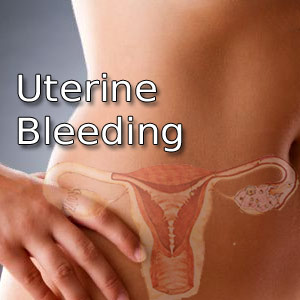Dysfunctional Uterine Bleeding

Nearly 14 percent of women experience irregular or excessively heavy menstrual bleeding or dysfunctional Uterine Bleeding (DUB) which is defined as 'abnormal bleeding of the genital tract and it is based in the uterus in the absence of organic diseases. It is found in the absence of any demonstrable structural or organic pathology.' In some instances, the term is used to refer to hormonal mechanism. Hormonal disturbances are usually the cause of DUB. In diagnosis, organic pathology must first be ruled out. DUB is classified as Ovulatory and Anovulatory, depending upon ovulation occurring or not.
Ovulatory DUB: About 10% women suffer from this. Here the progesterone secretion is prolonged as the estrogen levels are low. This causes irregular shedding of the uterine lining and breakthrough bleeding. Some associate ovulatory DUB with fragile blood vessels in the uterus.
This indicates possible endocrine dysfunction. This results in menorrhagia or metrorrhagia. A mid-cycle bleeding can indicate transient estrogen decline, while late cycle bleeding indicates progesterone deficiency.
Anovulatory DUB: Anovulatory menstrual cycles are common at the extremes of reproductive age such as puberty and perimenopause. This is a stage when women do not develop and release properly mature eggs. As a result, the corpus luteum, producer of progesterone, does not form. Consequently, estrogen is continuously produced and periods can be delayed or very heavy and prolonged when it occurs.
Symptoms of dysfunctional uterine bleeding
Symptoms of DUB might include mood swings, vaginal tenderness and hirsutism.
- Vaginal bleeding that occurs every 21 days or father apart than 35 days.
- Vaginal bleeding that lasts longer than 7 days.
- Blood loss of more than 80 ml, instead of the usual 30 ml during the menstrual cycle.
Causes and assessment of dysfunctional uterine bleeding
The cause of DUB could be a pathological disorder such as that of the endocrine or structural lesions or it could be induced by infections or medications.
Cushing's disease, immature hypothalamin-pituitary, axis, hyperprolacinemia, hypothyroidism, menopause, obesity, polycystic ovary disease, premature ovarian failure are some of the endocrinal causes of DUB. Structural lesions of cervix or vagina, endometrial cancer, uterine or cervical polyps and trauma can cause DUB.
Infections such as Chlamydia, gonorrhea, and PID can cause DUB. Medications including hormonal agents, low dose oral contraceptive pills, nonprogestin containing IUDs and non-steroidal anti-inflammatory drugs and Norplant systems, tamoxifen and warfarin can cause DUB.
Assessment should always start with a complete medical history and physical examination. Diagnostic tests include hemoglobin, luteinizing hormone, follicle stimulating hormone, prolactin, thyroid stimulating hormone, pregnancy BhCG, androgen and sometimes ultrasound and endometrial sampling if necessary. As part of the diagnosis, the patient might need to undergo endocervical smear, vulval inspection and abdominal examination for uterine and ovarian tenderness and palpable mass.
Treatment and management of DUB
The primary goal of treating dysfunctional uterine bleeding is to arrest bleeding. Replacement of iron loss, avoidance of anemia and prevention of future bleeding are other goals.
DUB is usually managed with medicine to reduce bleeding. The drug of choice in DUB is progesterone; to reduce bleeding, and regulate periods.
Also, hormonal therapy which is nonspecific is used; such as combined with high dose estrogen and high dose progestin. Ormeloxifene is another non-hormonal medication that treats DUB but all these drugs can be taken only under prescription by an authorized medical attendant only. Such hormonal therapy either stops or regulates menstrual periods.
In some cases hysterectomy is performed. Surgical treatment is reserved for bleeding that cannot be controlled with medicine or hormone therapy. In case of acute, severe uterine bleeding a short course of high dose estrogen therapy is done. If this is not effective, especially in rare cases, a dilation and curettage is done to clear the uterus of tissue. If necessary, blood transfusion is carried out to quickly restore needed blood volume.
For ongoing treatment of uterine bleeding, certain factors such as age, cause of the condition, future plans of the patient such as pregnancy must be considered. If you are in your teens, wait till the periods get more regular. A doctor may prescribe progestin or birth control pills to regulate the cycle.
If you are not ovulating regularly, and it is difficult to predict how long the irregular bleeding will last, you may be given hormone therapy. In case, you have no future childbearing plans, and suffer severe symptoms, you can opt for surgical treatment to remove uterus or to destroy the uterine lining.
If you are ovulating regularly, and suffer irregular vaginal bleeding and plan to become pregnant in the future, talk to your doctor about various treatment options. Oral progestin or birth control pills may be suggested until the bleeding become more regular. If you have no future pregnancy plans, consider endometrial ablation or hysterectomy.
Gonodotropin releasing hormone analogues (GnRH-As) are rarely used these days. These drugs reduce the production of estrogen and make your body think that it is menopause but the moment you discontinue medicines, the symptoms will recur, along with side effects of this treatment.
In all, it is estimated that 5% of women between the age groups of 30 to 49 seek treatment each year for DUB. 30% of women experience DUB at some time or the other. Although DUB is a common health issue among women, diagnosing DUB can be very frustrating for doctors, as this is a diagnosis of exclusion.
Top of the Page: Dysfunctional Uterine Bleeding
Tags:#dysfunctional uterine bleeding #DUB

Inserting Tampon
Pre Menstrual Syndrome Symptom
Painful Menstrual Cramps
Prolonged Menstruation
Menstrual Regulation
Menstruation after Birth
Menstrual Cup
Menstruation and Breastfeeding
Dysfunctional Uterine Bleeding
Breakthrough Bleeding
Uterine Fibroid Embolization
Vaginal Bleeding After Menopause
Menopause Symptom
Hormone Replacement Therapy
Black Cohosh
Pelvic Inflammatory Disease
Top of the Page: Dysfunctional Uterine Bleeding
Popularity Index: 101,915

